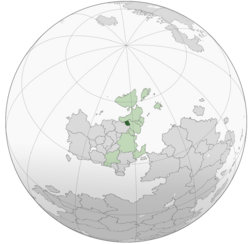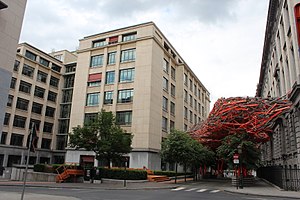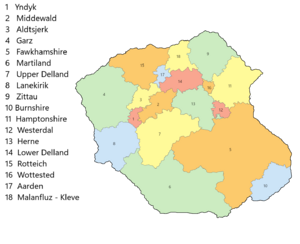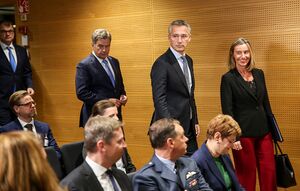User:Poshyte/Sandbox4
United Provinces of Alsland | |
|---|---|
| Motto: Tegearre (Dellish) Zusammen (Weranian) Gẹdor (Swathish) Koos (Kirenian) Together | |
| Anthem: Aalslânsk grûn (Dellish) Alslandic ground | |
 Alsland (dark green) in Euclea (light green and dark grey) and in the Euclean Community (light green). | |
| Capital and largest city | Yndyk |
| Official languages | Dellish Weranian Swathish Kirenian |
| Recognised regional languages | Estmerish |
| Ethnic groups | 86.3% Alslandic background 13.7% Foreign background |
| Religion |
|
| Demonym(s) | Alslandic |
| Government | Federal parliamentary republic |
| Hepke Veltman | |
• Premier | Ottila Möller |
| Legislature | Federal Assembly |
| Federal Council | |
| Folkssenaat | |
| Independence from Kirenia | |
• Declared | 1919 |
• Recognised | 1921 |
| Area | |
• | 46,789 km2 (18,065 sq mi) |
• Water (%) | 1.2% |
| Population | |
• 2020 estimate | 11,501,738 |
• 2019 census | 11,384,499 |
• Density | 243/km2 (629.4/sq mi) |
| GDP (PPP) | 2020 estimate |
• Total | €564.5 Billion |
• Per capita | €49,583 |
| GDP (nominal) | 2020 estimate |
• Total | €539.3 Billion |
• Per capita | €47,374 |
| Gini (2020) | 34 medium |
| HDI (2020) | very high |
| Currency | (€) Euclo (EUC) |
| Date format | dd-mm-yyyy |
| Driving side | right |
| Calling code | +32 |
| Internet TLD | .as |
Alsland (Dellish: Aalslân; Weranian: Aalsland; Swathish: Ẹlsland) officially the United Provinces of Alsland is a country in Northern Euclea. It is bordered by Werania to the north, Estmere to the east and Kirenia to the west. It covers an area of 46,789 km2 (18,065 sq mi) and has a population of more than 11.5 million. The capital and largest city is Yndyk; other major cities are Wottested, Werdau, Kirchester, Glauchau, Leens, Hurdegaryp, and Ilfracombe. Alsland is divided into 4 autonomous communities: the Dellish Community, the Holsaten Community, the Swathish Community and the Martish Community.
Alsland was first inhabited by Weranic tribes since antiquity. Alsland was also home to Tenic tribes and Kirenian peoples. Due to the Neeves mountain range Alsland was isolated from the Solarian Empire. After the collapse of the Solarian Empire various petty kingdoms rose throughout Alsland the most notable being the Kingdom of the Fawkish in the southeast. The petty kingdoms were incorporated into the Rudolphine Confederation. During the Amendist Wars the Alslandic petty kingdoms sided with the Amendist League. The Alslandic petty kingdoms remained with the Rudolphine Confederation until the Ten Years' War when they were annexed by Kirenia.
During the War of the Triple Alliance, the Transneevan Republic was established in 1852. During the Republic's brief lifespan it was able to unite the 4 distinct cultures of Alsland into one common shared identity. The Republic was dissolved following the War and the territories were reincorporated back into Kirenia and Estmere. The common Alslandic identity persisted throughout the 19th century and the region became one of the major economic centres of Kirenia. During the April Revolution in Kirenia, Alslandic politicians issued the Declaration of the Independence of the State of Alsland. The fledgling state was invaded and mostly occupied by Werania and Estmere during the July Crisis in 1920. The country retained it's independence following the war and declared neutrality shortly afterwards. Alsland was invaded in August 1929 by Gaullica during the Great War. The occupation of Alsland by Gaullica reopened a discussion in Werania and Estmere over dissolving the country following the war which was met with protest from the government-in-exile led by Villem Mand. The country was liberated near the war's end with some pockets of collaborationist guerilla fighters in the Neeves fighting until the surrender of Gaullica. Following the war Alsland aligned itself with Kirenia politically and culturally until 1949 when it declared neutrality in the face of the Kirenian-Weranian War. Alsland joined the Euclean Community in 1955 and the Euclozone in 2001. The 2005 global Financial crisis and the preceding 2004 Alslandic financial crisis devastated the Alslandic economy which has remained relatively stagnant compared to it's Euclean neighbours after the crisis Despite this the country is considered to have a 'very high' and has a High average income.
Alsland is a liberal democracy with a mixed market economy; Alsland's welfare state - which is one of the most extensive in Euclea - also provides subsidised Education and Healthcare. Following the great-war, the influence of Cooperatives in Alsland has increased; according to a 2018 study by the AEDC, Alsland has the highest number of cooperatives in the Euclean Community. The country is considered to have a 'very high' and has a High average income. The country is a member of the Euclean Community, the Northern Forum, the AEDC, ECDTO, the International Council for Democracy and the Community of Nations.
Etymology
- Weranic tribe
- Usage post-Revolution
- Alternate names
History
Weranic tribes
- Immigration into Alsland
- Solarians
Early Middle ages
- Petty Kingdoms
- Kingdom of the Fawkish
Middle ages
- James the Great and Fawkish domination
- Rudolphine Confederation
- Amendist War
Kirenian rule
- Kirenian annexation
- Werdau revolution
- Industrial centre
- United People's Party
- Great collapse
- Airdale war
- April revolution
Independence and July Crisis
- Alslandic revolution
- Republic of Alsland
- July Crisis
- Buffer state
- Land reform and pillarisation
Great War and modern era
- Reconstruction
- Kirenian realignment
- Neutrality
- Joining the EC
- Language reforms
- Financial crisis and it's effects (Separatism, Austerity post-2009, lack of trust in federal institutions)
Geography
- Neighbouring countries
- Area
- Neeves
- Natural resources
Climate
- Climate types
- Average temperature
- Percipitation and sunlight
- Temperature extremes
Biodiversity
- National parks
- Forests
- Native animals
- Flora
Politics and Government
Government

Political parties
- Needs to be nuked
Provinces
Alsland is divided into 18 Provinces. The provinces of Alsland each are members of a community and each province has a high level of autonomy with their own governments, legislatures and constitutions. The most populated province is X with X inhabitants. The largest province by area is Fawkhamshire which is also the least densely populated province. Wottested is the smallest province by area but has the highest population density of every province.
Law
- Supreme court
- Rehabilitation
- Crime rate
Foreign relations
Foreign relations of Alsland are handled by the Department of Foreign Affairs and the Secretary of Foreign Affairs. Alsland maintains embassies and consulates in most countries around the world. Yndyk is home to several dozen foreign embassies.
Alsland has been a member of the Euclean Community since 1955. Alslandic policy towards the EC has become progressively more euclofederalist. Successive Alslandic governments have endorsed plans for a single EC army and backed further integration of EC member states. During Bonne Zijlstra's tenure as President of the Euclean Community, Alsland's linguistic diversity was frequently used as a model for a potential united Euclean state. Within the EC, Alsland has frequently aligned itself with smaller member states such as Azmara, Borland, Caldia, Hennehouwe and Kesselbourg. Alsland has a particularly strong relation with Azmara and Borland which has led to the term "Alsbora" to be used when referring to the three countries collectively.
Alsland has a unique relationship with Kirenia. Alsland has generally more positive relations with the country and post-independence had a pro-Kirenian foreign policy particularly after the Estmerish-Weranian invasion and occupation of Delland. The Kirenian-Weranian war led to an outbreak of ethnic violence in Alsland such as the 1950 Rahu riots which left several people dead. Overtime Alslandic foreign policy has drifted towards eastern Euclea however Alsland maintains strong relations with Kirenia and other MASSOR member states.
Furthermore, Alsland is a founding member of the Community of Nations and the International Council for Democracy. It is also a member of the Euclean Common Defence Treaty Organisation (ECDTO), the Association for Economic Development and Cooperation (AEDC), the International Trade Organization (ITO), the Global Institute for Fiscal Affairs (GIFA) and the Estmerish Community.
Armed Forces

The Alslandic Defence force (Definsjemacht) currently numbers 28,000 active personnel. In 2020 the defence budget was set at €5.932 Billion (1.1% of Alsland's GDP). The Definsjemacht is split into 3 branches, the Federaal leger (ground forces), the Federale loftmacht (air force) and the Federale garde (home guard). Until 1968, Military service was compulsory for Alslandic men at age 18 but this was changed and since 1970 the Definsjemacht has operated on a purely voluntary service unless in wartime when conscription may be reintroduced.
The President is the commander in chief of the Alslandic armed forces, since 2018 this has been Hepke Veltman. The Secretary of Defence is usually a former or current member of the Armed Forces. The last conflict Alsland was involved in militarily was the Great War however the Definsjemacht has been deployed on several occasions since then most notably in 1975 during the Martiland Strikes and in 2000 during the Euclogaos protests. It was deployed most recently in 2021 after the Yndyk train bombing as part of a broad scheme to help law enforcement prevent future terrorist attacks. Definsjemacht soldiers have since been spotted at key transport hubs such as train stations and airports.
Economy
- Brief description
- Adoption of the Euclo (Euclogaos)
- Notable exports/imports
- Financial centres
Stagnation
Financial
- Yndyk stock exchange
- Financial & services sector
Tourism
- Annual visitors
- Skiing
- Cultural sites
Infrastructure
As of 2020, 48% of Alsland's energy production came from nuclear power and other renewable sources. Nuclear power is Alsland's largest source of electricity. Despite this in 2012, the liberal led government backed a proposal by the green party to phase out nuclear power by 2035. The move was criticised by other environmental groups and sparked backlash against the government. Despite this subsequent governments have affirmed the timeline of phasing out nuclear power in Alsland. Anti-nuclear activists also blocked the construction of a nuclear power plant in 2011.
Due to Alsland's central location in Northern Euclea it is a transport hub between several neighbouring states. The motorway system in Alsland, the Autodyk in Dellish, the Autobahn in Weranian and the Kiirtee in Kirenian, spans the entire country. The Autodyk spans 1,747 km (1,086 mi) across Alsland and spreads across each province in the country. Each section of the Autodyk is operated and managed by the province it is in. Alsrail, the national rail transport operator is the most used form of public transportation in Alsland, it also connects with neighbouring countries and the Euclostar network. There are over X km (X mi) of rail track in Alsland. Since 2017, cycling infrastructure has seen a large expansion notably in the Yndyk Province. This has coincided with a federal campaign to promote cycling in Alsland. As of 2020 there are 218 km of cycling lanes in Yndyk making it the Xth most bike-friendly city. On average 153,211 or 24% of Yndyk's population now commute to work via bike.
The largest airports in Alsland are Wottested-Yndyk International Airport, Yndyk City Airport and Ilfracombe International Airport. Over 26,000,000 passengers flew through Wottested-Yndyk International Airport in 2020 making it the Xth busiest airport in Euclea.
Demographics
- Population density
- Population growth and population pyramid
- Average age
| Rank | Communities | Pop. | Rank | Communities | Pop. | ||||
|---|---|---|---|---|---|---|---|---|---|
 Yndyk  Wottested |
1 | Yndyk | Delland | TBD | 11 | Boalsert | Delland | TBD |  Werdau  Kirchester |
| 2 | Wottested | Delland | TBD | 12 | Krikkested | Delland | TBD | ||
| 3 | Werdau | Holsteen | TBD | 13 | Merrow | Upper Swerdia | TBD | ||
| 4 | Kirchester | Upper Swerdia | TBD | 14 | Sydenham | Upper Swerdia | TBD | ||
| 5 | Rahu | Martiland | TBD | 15 | Paiski | Martish Community | TBD | ||
| 6 | Glauchau | Holsteen | TBD | 16 | Allkau | Holsteen | TBD | ||
| 7 | Leens | Delland | TBD | 17 | Lahnbeuren | Holsteen | TBD | ||
| 8 | Ilfracombe | Upper Swerdia | TBD | 18 | Wolvegea | Delland | TBD | ||
| 9 | Hurdegaryp | Delland | TBD | 19 | Sachsenscheid | Holsteen | TBD | ||
| 10 | Rikertsted | Delland | TBD | 20 | Millhurst | Upper Swerdia | TBD | ||
Migrants
- Immigration
- Largest migrant communities
- Restrictions on non-EC immigration
- % of foreign born Alslandic citizens
 Werania
Werania- Template:Country data Estmere
 Kirenia
Kirenia Hennehouwe
HennehouweGaullica
Piraea
 Mabifia
Mabifia Etruria
Etruria Zorasan
Zorasan Shangea
Shangea
Language
- Languages
- Alslandic Weranian and Alslandic Swathish
Religion
- Local churches
- Relationship between state and church
- Poll on religious views
Health
- Life expectancy
- Replacement rate
- Health inequalities
- Health problems
- State health service
- Euthanasia in Swerdia
Education
- Brief rundown on education system
- Trade schools
- Tertiary education
- Adult education
Culture
Art
- Famous artists over time
- Notable art pieces
- Art museums
Literature
Literature in Alsland has a deep history going back to the middle ages and the works of Alslandic monks and philosophers. Early Alslandic literature paved the way for several sotirian philosophical movements. During the Ten Years' War and much of the 19th century, Alslandic literature was notable for it's existential dread and many pieces of work during this time were self-censored by their authors in fear of reprisal by Kirenian authorities. Alslandic literature experienced a crisis between 1880 and 1940 when very few notable pieces of Alslandic literature were produced. The Great War and Alsland's reconstruction era fuelled a revitalisation of literature. Late 20th century literature in Alsland was recognisable for it's various themes and outlook on society. Today, literature in Alsland is diverse and has produced several important works of literature.
Well-known Alslandic authors include Liewer Halma, Hilda Schaaf, Ebe Van Der Heide, K.A Zimmermann, Ernest Dixon, Erlend Vesik, and Raiko Rummo. Notable pieces of Alslandic literature include, Watercolour birds, the romanticist influenced Finsterbank series and Taivo Janese lugu which was written during the Gaullican occupation by pianist Taivo Janese and was published after he was killed in the Battle of Wottested. In modern days Alslandic literature has seen a revival, Watercolour birds which was published in 2002 went on to become a global bestseller and sold an estimated 49 million copies globally making it the xth best selling book globally. The book's author, Hilda Schaaf became the first Alslander to win a Foirbeis Prize for Literature.
Music
- Local music
- Classical music
- Modern music & famous artists
Media
Sport

Cuisine
- Most popular dishes
- Local dishes
- National dish
Holidays
| Autonomous communities | |||||||
|---|---|---|---|---|---|---|---|
| Date | Estmerish name | Local Name | Notes | ||||
| 1 January | New Year's Day | Nijjiersdei | |||||
| 12 February | Patriot's day | Patriotten dei | |||||
| 2 March | Swathish Language Day | Svạþiṡc lẏdenn dạg | Held annually to celebrate the Swathish identity | ||||
| Changeable | Easter | Peaske | |||||
| Changeable | Easter monday | Peaske moandei | |||||
| 22 April | Remembrance Day | Mälestuspäeva | Held annually following the Rahu Massacre | ||||
| 1 May | Labour Day | Dei fan de Arbeid | |||||
| 30 July | Saint Alfhard's day | Tag des Heiligen Alfhard | Celebrates the patron saint of Garz and Zittau | ||||
| 18 October | Freedom Day | Frijheidsdei | Celebrates the 1919 original declaration of Dellish independence | ||||
| 22 November | Constitution Day | Grûnwetdei | |||||
| 24 December | Nativity's eve | Krystjûn | |||||
| 25 December | Nativity | Krystfeest | |||||
| 31 December | New Year's eve | Âldjiersjûn | |||||








